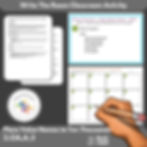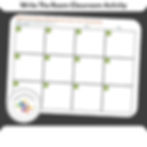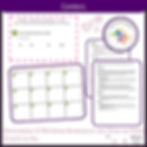Great lesson plans make all the difference. Whether you're an experienced teacher or new to the classroom, the foundation of effective teaching lies in a well-structured lesson plan. In this article, we'll explore the essential characteristics of a good lesson plan, highlighting why it's important and how it can enhance student learning and engagement.
What You Will Learn:
The importance of having a clear objective in a lesson plan
How to organize lesson content effectively
Strategies for creating student-centered and engaging activities
The role of assessment in lesson planning
Tips for differentiating instruction to meet diverse student needs
How to incorporate technology and real-life examples into your lessons
The benefits of collaboration and group work
Methods for providing reflection and feedback
The necessity of flexibility and adaptability in lesson planning
Practical considerations such as time management and addressing possible misconceptions
Three types of lesson plans:
The one you write with thoughts from your head to get you through next week.
The one you write for admin to meet the requirements of some new initiative.
The one you want to follow from a curriculum book because it accounts for every possible scenario and has optional side activities.
A Great lesson plan can be followed step by step and provide students with the information they need to learn. It should be easy for the teacher to explain, implement, and assess student progress. A great lesson plan should include learning objectives and a clear explanation of what will be taught and how it will be taught. The lesson plan should also include materials needed for the activity or discussion (if any) and a timeline for completing the task. It should also outline appropriate learning activities that align with the identified learning objectives. It should also provide an assessment of learning at the end to evaluate student mastery of the material. Finally, a great lesson plan should be flexible enough to allow for improvisation and adaptation if needed to better meet each student’s needs by adjusting instructional strategies.
Clear Objective:
A great lesson plan has a clear and concise objective that is easy to understand. This helps ensure that the students can focus on the task at hand and know what they are working towards.
Well-organized Content:
The content of a great lesson plan is well-organized and easy to follow. This makes it less likely that students will become lost or confused and helps keep them on track.
Student-centered Approach:
A great lesson plan takes a student-centered approach, which means that it is designed to meet the individual needs of each student. This ensures that all students can learn and grow in a supportive environment.
Engaging Activities:
A great lesson plan should include engaging activities that keep students motivated and interested in the material. These can be hands-on projects, discussions, games, or any other activity that will promote student learning and spark students' attention.
Assessment:
Finally, a great lesson plan includes an assessment of the student’s learning. This assessment should be based on the lesson’s objective and provide feedback so that teachers and students can determine if they have met the goal. Teachers can track individual progress and overall success with a given lesson by including assessments.
The best practice is to plan ahead. Start with a blank lesson plan template and fill in the details as you go along. Think about how each activity or discussion fits into the overall goal of the lesson, what materials are needed, and how you will assess student learning at the end. With a great lesson plan, teachers can set their students up for success and ensure that each student reaches their learning goals.
A well-crafted lesson plan is an essential tool for any teacher. It helps to organize the content, keep students on track, and meet the individual needs of each student. A great lesson plan should also include engaging activities that promote learning and assess student progress. By following these tips, teachers can create a successful lesson plan that will help their students learn and grow.
Why a Good Lesson Plan Matters
When we talk about the impact of a good lesson plan, we need to consider both the short-term and long-term effects on students. In the short term, a well-structured lesson plan ensures that students understand the day’s objectives and can follow along with the activities and discussions. This clarity reduces confusion and keeps students engaged.
In the long term, consistent use of well-crafted lesson plans helps to build a solid foundation of knowledge and skills. Students can see the progression of their learning and understand how each lesson fits into the broader curriculum. This continuity is especially important for students who may need more support, as it provides a clear and predictable learning path.
Differentiation in Lesson Planning
One of the hallmarks of an excellent lesson plan is its ability to accommodate diverse learning styles and needs. Differentiation is key. This means tailoring instruction to meet the varied needs of all students, whether they require more challenging tasks or additional support to grasp the material.
For example, in a math lesson on fractions, some students might benefit from visual aids and hands-on activities, such as using fraction tiles. Others might excel with abstract problems and require advanced exercises to stay engaged. By incorporating different strategies, teachers ensure that every student can access the content and achieve the learning objectives.
Incorporating Technology
In today’s digital age, integrating technology into lesson plans can significantly enhance student learning. Tools such as interactive whiteboards, educational apps, and online resources provide dynamic ways to engage students. Technology can also facilitate differentiated instruction, allowing students to learn at their own pace through adaptive learning programs.
For instance, in a history lesson about ancient civilizations, students could use virtual reality to explore historical sites, watch documentary clips for a visual understanding, or participate in interactive quizzes to reinforce their knowledge. These varied approaches cater to different learning styles and make the lesson more engaging.
Collaboration and Group Work
A great lesson plan often includes opportunities for collaboration and group work. This not only helps students develop social and communication skills but also allows them to learn from one another. Collaborative activities can take many forms, such as group projects, peer review sessions, or classroom debates.
Consider a science lesson on ecosystems. Students could be divided into groups, each researching a different ecosystem. They would then present their findings to the class, providing a comprehensive overview of various ecosystems through a collaborative effort. This approach promotes teamwork and ensures that students are actively involved in their learning.
Reflection and Feedback
Another essential element of a good lesson plan is the inclusion of time for reflection and feedback. This could involve students reflecting on what they have learned and how they have learned it. Teachers can facilitate this through reflective journals, exit tickets, or class discussions.
Feedback is equally important. Constructive feedback helps students understand their strengths and areas for improvement. It also informs teachers about what works well and what might need adjustment in future lessons. This ongoing dialogue between students and teachers fosters a supportive learning environment and continuous improvement.
Flexibility and Adaptability
While structure and organization are crucial, flexibility is equally important in a lesson plan. Teachers need to be prepared to adjust their plans based on student responses and needs. This could mean spending more time on a challenging concept or accelerating through material that students grasp quickly.
For example, if a planned math lesson on geometry is not resonating with students, a teacher might pivot to using more hands-on activities, like building shapes with modeling clay, to make the concepts more tangible. Flexibility ensures that teaching remains responsive and effective, rather than rigidly sticking to a script.
Using Real-life Examples
Making connections to real-world scenarios can greatly enhance the relevance and impact of a lesson. When students see how what they are learning applies to real life, they are more likely to be engaged and motivated. This can be particularly powerful in subjects like science, math, and social studies.
For instance, in a lesson on statistics, students could analyze data from current events, such as election results or sports statistics. This not only makes the lesson more interesting but also helps students develop critical thinking skills as they interpret real-world data.
Incorporating Multiple Intelligences
Howard Gardner’s theory of multiple intelligences suggests that students have different kinds of intelligences, such as linguistic, logical-mathematical, spatial, and interpersonal. A well-rounded lesson plan incorporates activities that cater to these various intelligences, ensuring that every student has the opportunity to excel.
For example, an English lesson on poetry could include activities like writing poems (linguistic intelligence), analyzing the structure and patterns of poems (logical-mathematical intelligence), drawing illustrations for poems (spatial intelligence), and performing poems (interpersonal intelligence). By tapping into different intelligences, teachers can create a more inclusive and effective learning experience.
Building on Prior Knowledge
A great lesson plan builds on students’ prior knowledge. By connecting new concepts to what students already know, teachers can enhance student understanding and make learning more meaningful. This approach helps students see the relevance of new information and encourages deeper learning.
For example, in a science lesson about the water cycle, a teacher might start by discussing students’ experiences with rain and evaporation. By linking these everyday observations to scientific concepts, students can better grasp the material and see its application in their lives.
Direct Instruction
Direct instruction is a teaching approach that is systematic, explicit, and highly structured. It involves the teacher clearly presenting the material, modeling the process, and providing guided practice before allowing students to practice independently. A great lesson plan often incorporates direct instruction to ensure that students understand the material before moving on to more complex tasks.
For example, in a lesson on solving linear equations, a teacher might start by explaining the steps involved, demonstrating how to solve an equation, and then guiding students through several practice problems. This method ensures that students have a solid understanding before they work independently.
Formative Assessments
Formative assessments are an integral part of a great lesson plan. They provide ongoing feedback that can be used to adjust instruction and improve student learning. Examples of formative assessments include quizzes, exit tickets, and informal observations.
For instance, after a lesson on photosynthesis, a teacher might use an exit ticket where students write down one thing they learned and one question they still have. This provides immediate feedback on student understanding and informs the teacher’s next steps.
Creating a great lesson plan is both an art and a science. It requires careful planning, a deep understanding of student needs, and the flexibility to adapt as necessary. A well-crafted lesson plan sets clear objectives, organizes content effectively, engages students with varied activities, and includes assessments to measure progress. By incorporating elements such as differentiation, technology, collaboration, reflection, real-world connections, building on prior knowledge, direct instruction, and formative assessments, teachers can design lessons that not only educate but also inspire and motivate students.
Are you feeling inspired to create your own stellar lesson plan? Let us know how it goes in the comments below!

































